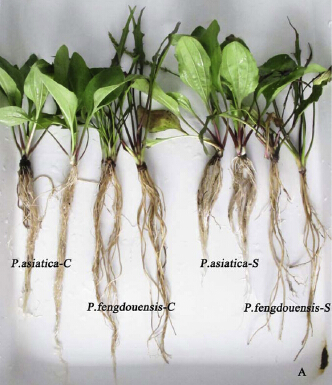Dissecting Tissue- and Species-specific Responses of Two Plantago Species to Waterlogging Stress Enlightens Ex Situ Populations Reconstruction
2014-12-15
Plantago fengdouensis (P. fengdouensis), an endangered plant native to the Three Gorge Reservoir area of China, is discovered in only two small islands of two counties along the Yangtze River in the Three Gorges Reservoir. Its natural habitat was seasonally flooded due to summer flooding of Yangtze River, and completely and perpetually submerged after the impoundment of the Three Gorges Reservoir.
Waterlogging often occurs in many parts of the world every year. It often disturbs the plant growth, development, production, and many physiological functions. However, physiological responses of P. fengdouensis to waterlogging stress were not clear.
Dr. YANG Fan, supervised by Prof. CHAN Zhulong from Wuhan Botanical Garden, compared the different responses to waterlogging stress between P. fengdouensis and Plantago asiatica L. (P. asiatica) widely distributing in Asia in term of changes of reactive oxygen species (ROS) accumulation, membrane lipid peroxidation, free proline, and antioxidant defense systems.
In this study, histochemical staining and quantification assay were employed, results suggested that leaves of P. fengdouensis were more sensitive to waterlogging stress than that of P. asiatica, while the roots of P. fengdouensis were more tolerant to waterlogging stress than that of P. asiatica in term of accumulation of hydrogen peroxide (H2O2), superoxide radical (O2?), hydroxyl radical (OH) and malondialdehyde (MDA) levels. In addition, P. fengdouensis were more tolerant to waterlogging stress in term of reduced glutathione (GSH) accumulation, free proline levels and activities of catalase (CAT), ascorbate peroxidase (APx), and glutathione reductase (GR) than P. asiatica, especially in root systems.
All these results showed that as for P. asiatica, leaves of P. fengdouensis were more sensitive to waterlogging stress, while roots more tolerant, which may be positively related to its natural inhabiting conditions. P. fengdouensis naturally inhabiting in the island along the Yangtze River had to endure the summer flooding. All leaves of flooded P. fengdouensis seedlings died and felled after submergence, thus survival and recovering of this plant mainly depended on root system.
These analyses on physiological responses of P. fengdouensis to waterlogging stress can be used as indicators of reconstruction of the ex situ populations of the in situ conserved P. fengdouensis.
Results were published in Environmental and Experimental Botany entitled “Dissecting tissue- and species-specific responses of twoPlantagospecies to waterlogging stress at physiological level”.

The morphological traits of two Plantogo species as affected by waterlogging. C represents control treatment and S represents stress treatment. (Image by YANG Fan)

Histochemical staining assay of leaves and roots sampled from two Plantogo species under control and stressed conditions for hydrogen peroxide (H2O2, A-B) and superoxide radical (O2?, C–D) by DAB and NBT, respectively. (Image by YANG Fan)